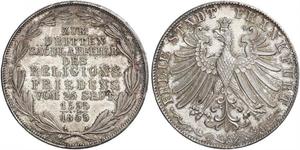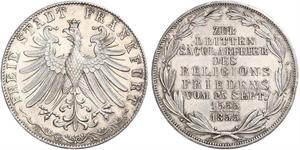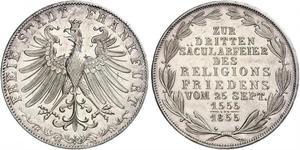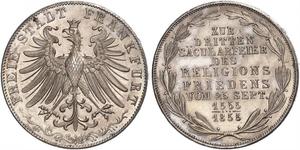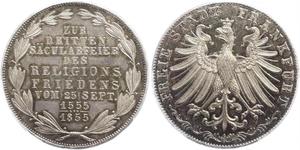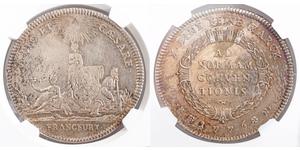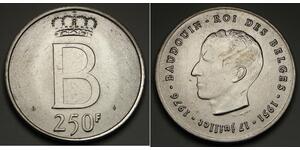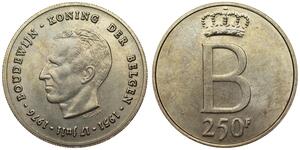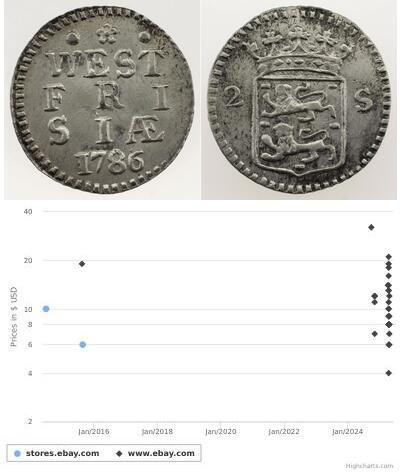2 Gulden Free City of Frankfurt Silver
1855, Frankfurt (Free City). Silver “Religious Peace” 2 Gulden Coin. PCGS MS-62! Mint Year: 1855References: KM-353. Mintage: Only 32,000 pcs! Denomination: 2 Gulden – 300th Anniversary of the Religious Peace of Ausgsburg! Weight: 21.21gm Diameter: 36mm Material: Silver Obverse: Legend in seven lines above anniversary dates of the Peace of Augsburg treaty. All within wreath. Legend: ZUR DRITTEN SÄCULARFEIER DES RELIGIONS FRIEDENS VOM 25. SEPT. 1555 / 1855 Translated. “For the 3rd Secular Celebrations of the Religious Peace of 25th of Sept 1555 / 1855” Reverse: Heraldic crowned eagle of Frankfurt looking left. Legend: FREIE STADT FRANKFURT (“Free City of Frankfurt”) Edge Legend: STARK IM RECHT After the ill-fated revolution of 1848, Frankfurt was the seat of the first democratically elected German parliament, the Frankfurt Parliament, which met in the Frankfurter Paulskirche (St. Paul’s Church) and was opened on 18 May 1848. The institution failed in 1849 when the Prussian king declared that he would not accept “a crown from the gutter”. In the year of its existence, the assembly developed a common constitution for a unified Germany, with the Prussian king as its monarch. Frankfurt lost its independence after the Austro-Prussian War as Prussia in 1866 annexed several smaller states, among them the free city of Frankfurt. The Prussian administration incorporated Frankfurt into its province of Hesse-Nassau. The formerly independent towns of Bornheim and Bockenheim were incorporated in 1890. The Peace of Augsburg, also called the Augsburg Settlement, was a treaty between Charles V and the forces of the Schmalkaldic League, an alliance of Lutheran princes, on September 25, 1555, at the imperial city of Augsburg, now in present-day Bavaria, Germany. It officially ended the religious struggle between the two groups and made the legal division of Christendom permanent within the Holy Roman Empire. The Peace established the principle Cuius regio, eius religio, which allowed German princes to select either Lutheranism or Catholicism within the domains they controlled, ultimately reaffirming the independence they had over their states. Subjects, citizens, or residents who did not wish to conform to the prince’s choice were given a period in which they were free to migrate to different regions in which their desired religion had been accepted. Charles V had made a provisional ruling on the religious question, the Augsburg Interim of 1548; this offered a temporary ruling on the legitimacy of two religious creeds in the empire, and codified by law in 30 June 1548 upon the insistence of Charles V, who wanted to work out religious differences under the auspices of a general council of the Catholic Church. The Interim reflected largely Catholic principles of religious behavior in its 26 articles, but it did allow for marriage of the clergy, and bread and wine for the laity. This led to resistance by the Protestant territories, who proclaimed their own Interim at Leipzig the following year. The Interim was overthrown in 1552 by the revolt of the Protestant elector Maurice of Saxony and his allies. In the negotiations at Passau in the Summer of 1552, even the Catholic princes had called for a lasting peace, fearing the religious controversy would never be settled. The emperor, however, was unwilling to recognize the religious division in Western Christendom as permanent. This document was foreshadowed by the Peace of Passau, which in 1552 gave Lutherans religious freedom after a victory by Protestant armies. Under the Passau document. He granted a peace only until the next imperial Diet. Charles V called for the meeting in early 1555. The treaty, negotiated on Charles' behalf by his brother Ferdinand, effectively gave Lutheranism official status within the domains of the Holy Roman Empire. According to the policy of cuius regio, eius religio (“whose realm, his religion”, or “in the Prince's land, the Prince's religion”), the religion (Roman Catholic or Lutheran) of a region’s ruler determined the religion of its people. During a grace period, families could choose to move to a region where their faith was practiced. (Article 24: “In case our subjects, whether belonging to the old religion or the Augsburg Confession, should intend leaving their homes with their wives and children in order to settle in another, they shall be hindered neither in the sale of their estates after due payment of the local taxes nor injured in their honour.”) Knights and towns who had practiced Lutheranism for some time were exempted under the Declaratio Ferdinandei, but the Ecclesiastical reservation supposedly prevented the principle of cuius regio, eius religio from being applied if an ecclesiastical ruler converted to Lutheranism.
type to read more
55
coins in the group
View all coins in the group
View all coins in the group
(740 X 371 pixels, file size: ~67K)
Posted by: anonymous 2020-11-16
1855,Frankfurt, Stadt. Gedenkdoppelgulden 1855. Jaeger 49, AKS 42. Fein zaponiert. Schöne Patina. Fast Stempelglanz.
(1500 X 751 pixels, file size: ~245K)
Posted by: anonymous 2019-03-24
Frankfurt, Stadt. Doppelgulden 1855. Religionsfrieden. Jaeger 49, Thun 138, AKS 42, Kahnt 179. Schöne Patina. Winzige Randfehler, vorzüglich +
(1500 X 750 pixels, file size: ~227K)
Posted by: anonymous 2019-03-24
Frankfurt, Stadt. Doppelgulden 1855. Religionsfrieden. Jaeger 49, Thun 138, AKS 42, Kahnt 179. Vorzüglich +
(1500 X 751 pixels, file size: ~233K)
Posted by: anonymous 2019-03-24
Frankfurt, Stadt. Doppelgulden 1855. Religionsfrieden. Jaeger 49, Thun 138, AKS 42, Kahnt 179. Winzige Kratzer, vorzüglich - Stempelglanz
(1500 X 751 pixels, file size: ~219K)
Posted by: anonymous 2018-03-15
Frankfurt, Stadt. Doppelgulden 1855. Auf den Religionsfrieden. Jaeger 49, Thun 138, AKS 42, Kahnt 179.Vorzüglich - Stempelglanz
(1500 X 743 pixels, file size: ~204K)
Posted by: anonymous 2018-03-30
Frankfurt, Stadt. Gedenkdoppelgulden 1855. Religionsfrieden. Jaeger 49, AKS 42. In US Plastic-Holder PCGS MS63.Schöne Patina. Fast Stempelglanz
Articles
|
You may be interested in following coins
2025-07-05
- New coin is added to 250 Franc Belgium Silver Leopold III of Belgium
250 Franc Belgium Silver Leopold III of Belgium
group has 7 coins / 7 prices
⇑
Belgium - 250 Francs 1951 - Baudouin I, Dutch tekst, Silver
2025-05-24
- Historical Coin Prices
You may be interested in ...



